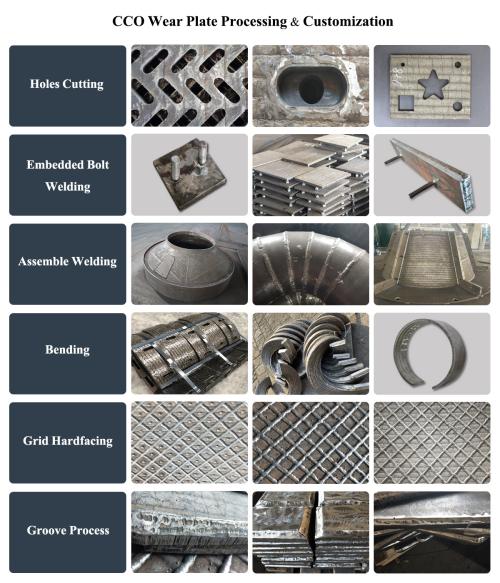Overlay Wear Plate Processing and Customization Services
In modern industrial production, CCO wear plate (chromium carbide overlay wear-resistant plate) is widely used in high-wear environments such as mining, building materials, steel, and electricity due to its excellent wear resistance and diverse processing adaptability. It is made of high-carbon high-chromium alloy welded on the surface of a low-carbon steel substrate, forming a bimetallic wear-resistant composite structure with great toughness and hardness, which can effectively extend the service life of equipment and reduce maintenance costs. This article will introduce the composition, performance characteristics, and customized processing services of CCO wear plate to help users better understand and apply this material.
Composition of overlay wear-resistant plate
High-carbon high-chromium alloy is the core material of the CCO wear plate. Its main component can form a large amount of Cr7C3 hard carbide under high temperature and high pressure conditions, forming a eutectic + M7C3 microstructure. This structure determines its excellent wear resistance, which remains stable even in complex wear environments. To improve the overall performance, micro-alloy elements such as molybdenum, tungsten, vanadium, boron, and niobium can also be added to the material to enhance high-temperature hardness, impact resistance, and corrosion resistance.
M7C3 carbides are arranged longitudinally under the microstructure. This structure can still maintain good performance under high temperature or severe friction conditions, far exceeding ordinary steel.
Key performance of the overlay wear-resistant plate
Impact resistance is one of the important criteria for judging the quality of wear-resistant plates. The metallurgical bonding layer of the CCO wear-resistant plate makes the covering layer firmly attached to the steel plate substrate, not easy to fall off, and remains stable and reliable even under strong impact or high load.
CCO plates can achieve precise segmentation by laser, plasma, and can also be processed in various forms, such as cold bending, drilling, welding, etc., without significantly weakening their wear resistance. For example, a 5+5 overlay wear plate (5mm substrate + 5mm cladding layer) is a common structural type, which not only retains structural strength but also takes into account economy and processing flexibility.
Overlay wear-resistant plate processing service
While providing CCO wear-resistant plate products, Wodon will also provide complete processing services. In terms of cutting, plasma or laser equipment is used for high-precision cutting, which is not only efficient and has a small heat-affected zone, but also has excellent finished product quality.
In terms of bending and forming, for example, bimetallic wear-resistant composite steel plates can be cold-processed into curved or conical parts to meet the application requirements of complex equipment components. Drilling services include straight hole and countersunk hole processing, which is convenient for subsequent bolt connection or welding installation. In addition, this type of wear-resistant plate has good weldability and can be used to make wear-resistant parts such as excavator buckets, liners, and conveyor system bushings.
Customized service
Considering the specific differences in the needs of different industries and equipment for wear-resistant materials, Wodon also provides customized size wear-resistant plate solutions. The thickness of the surfacing layer, the size of the plate, and other parameters can be adjusted according to user requirements to ensure that the product is accurately matched with the actual application. For example, in the application of mine conveying pipeline lining, thick surfacing layers and corrosion-resistant composite plates can be provided to increase service life.
Post time: Apr-18-2025

